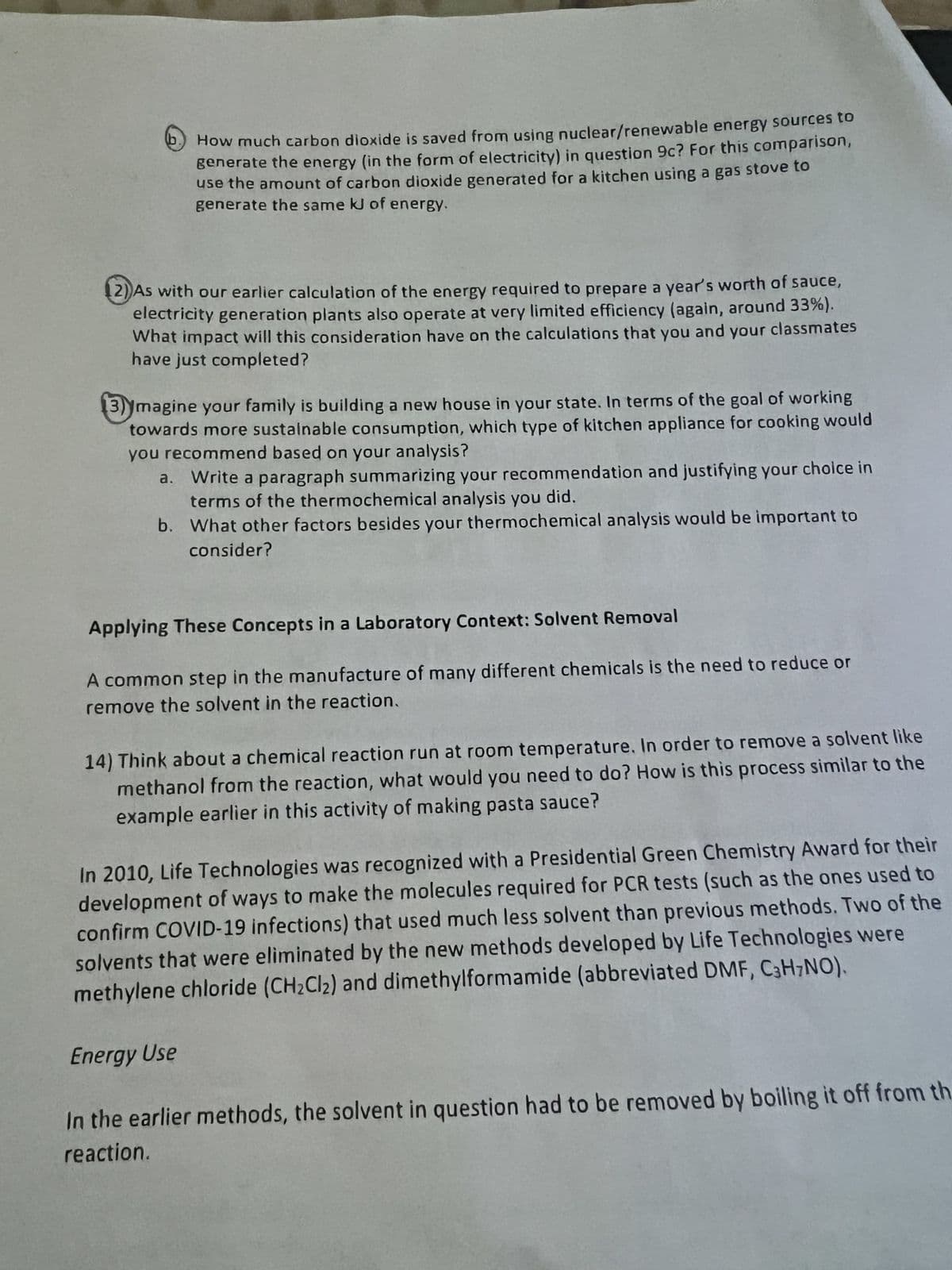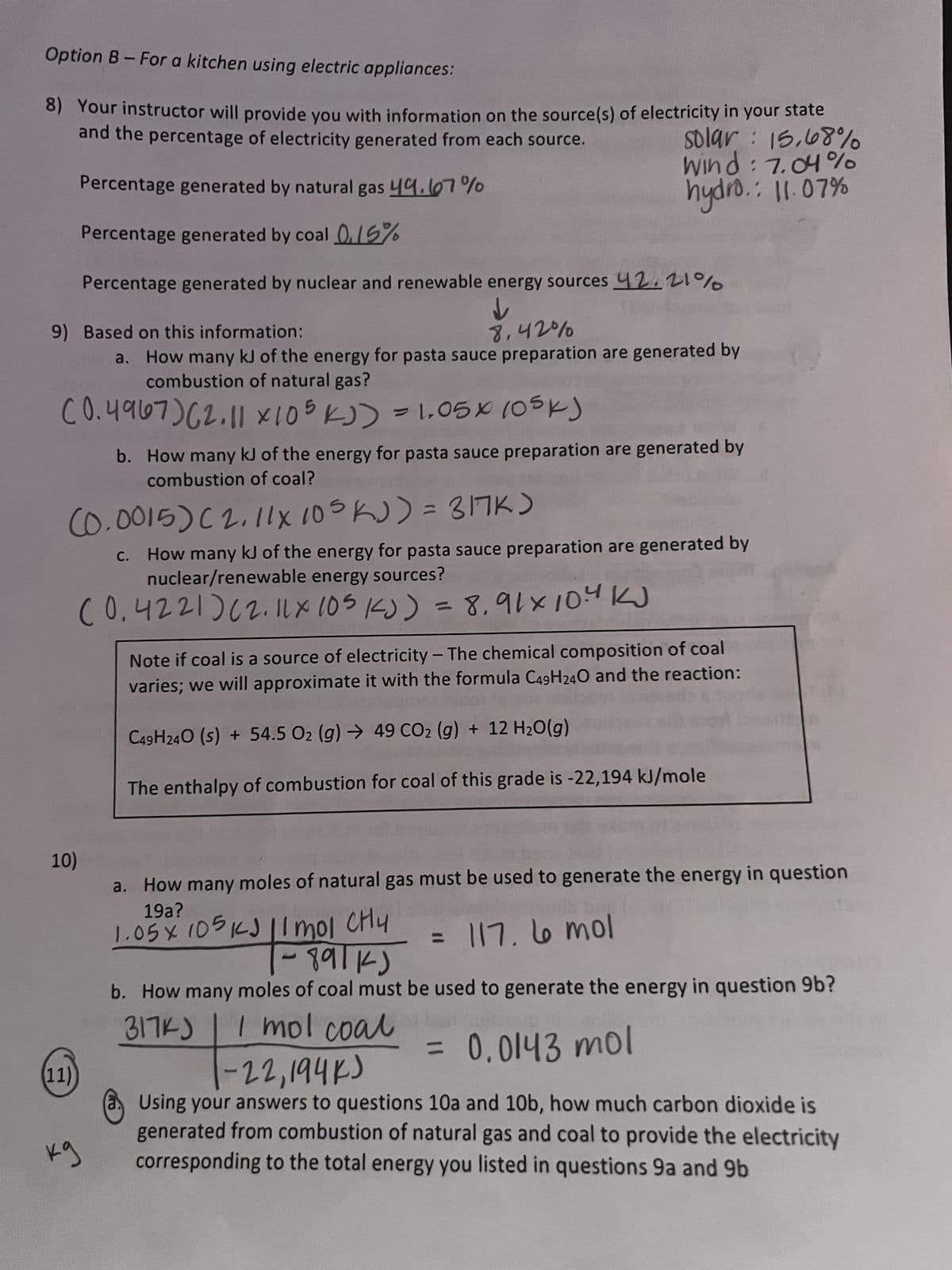(11) kg 1-22,194K) Using your answers to questions 10a and 10b, how much carbon dioxide is generated from combustion of natural gas and coal to provide the electricity corresponding to the total energy you listed in questions 9a and 9b
(11) kg 1-22,194K) Using your answers to questions 10a and 10b, how much carbon dioxide is generated from combustion of natural gas and coal to provide the electricity corresponding to the total energy you listed in questions 9a and 9b
Chemistry: Principles and Reactions
8th Edition
ISBN:9781305079373
Author:William L. Masterton, Cecile N. Hurley
Publisher:William L. Masterton, Cecile N. Hurley
Chapter8: Thermochemistry
Section: Chapter Questions
Problem 49QAP: Chlorine trifluoride is a toxic, intensely reactive gas. It was used in World War II to make...
Related questions
Question
100%
Please help me work out question 11a and 11b.

Transcribed Image Text:b
How much carbon dioxide is saved from using nuclear/renewable energy sources to
generate the energy (in the form of electricity) in question 9c? For this comparison,
use the amount of carbon dioxide generated for a kitchen using a gas stove to
generate the same KJ of energy.
2) As with our earlier calculation of the energy required to prepare a year's worth of sauce,
electricity generation plants also operate at very limited efficiency (again, around 33%).
What impact will this consideration have on the calculations that you and your classmates
have just completed?
3)magine your family is building a new house in your state. In terms of the goal of working
towards more sustainable consumption, which type of kitchen appliance for cooking would
you recommend based on your analysis?
Write a paragraph summarizing your recommendation and justifying your choice in
terms of the thermochemical analysis you did.
b. What other factors besides your thermochemical analysis would be important to
consider?
a.
Applying These Concepts in a Laboratory Context: Solvent Removal
A common step in the manufacture of many different chemicals is the need to reduce or
remove the solvent in the reaction.
14) Think about a chemical reaction run at room temperature. In order to remove a solvent like
methanol from the reaction, what would you need to do? How is this process similar to the
example earlier in this activity of making pasta sauce?
In 2010, Life Technologies was recognized with a Presidential Green Chemistry Award for their
development of ways to make the molecules required for PCR tests (such as the ones used to
confirm COVID-19 infections) that used much less solvent than previous methods. Two of the
solvents that were eliminated by the new methods developed by Life Technologies were
methylene chloride (CH₂Cl₂) and dimethylformamide (abbreviated DMF, C3H7NO).
Energy Use
In the earlier methods, the solvent in question had to be removed by boiling it off from th
reaction.

Transcribed Image Text:Option B-For a kitchen using electric appliances:
8) Your instructor will provide you with information on the source(s) of electricity in your state
and the percentage of electricity generated from each source.
solar: 15,68%
Wind: 7.04%
hydro.: 11.07%
8.42%
a. How many kJ of the energy for pasta sauce preparation are generated by
combustion of natural gas?
(0.4967) (2.11 x 105 kJ) = 1.05x105k)
9) Based on this information:
Percentage generated by natural gas 49.67%
Percentage generated by coal 0.15%
Percentage generated by nuclear and renewable energy sources 42,21%
↓
10)
(0.0015) (2.11x 105 kJ) = 317K)
c. How many kJ of the energy for pasta sauce preparation are generated by
nuclear/renewable energy sources?
(0.4221) (2.11x 105 1J) = 8,91×10.4 KJ
(11)
kg
b. How many kJ of the energy for pasta sauce preparation are generated by
combustion of coal?
Note if coal is a source of electricity - The chemical composition of coal
varies; we will approximate it with the formula C49H24O and the reaction:
C49H240 (s) + 54.5 O₂ (g) → 49 CO₂ (g) + 12 H₂O(g)
The enthalpy of combustion for coal of this grade is -22,194 kJ/mole
a. How many moles of natural gas must be used to generate the energy in question
19a?
1.05 x 105 KJ 11 mol CHy
= 117. 6 mol
fun and
- 99114)
b. How many moles of coal must be used to generate the energy in question 9b?
317KJ
0.0143 mol
I mol coal
=
-22,194K)
Using your answers to questions 10a and 10b, how much carbon dioxide is
generated from combustion of natural gas and coal to provide the electricity
corresponding to the total energy you listed in questions 9a and 9b
Expert Solution
This question has been solved!
Explore an expertly crafted, step-by-step solution for a thorough understanding of key concepts.
This is a popular solution!
Trending now
This is a popular solution!
Step by step
Solved in 3 steps

Knowledge Booster
Learn more about
Need a deep-dive on the concept behind this application? Look no further. Learn more about this topic, chemistry and related others by exploring similar questions and additional content below.Recommended textbooks for you

Chemistry: Principles and Reactions
Chemistry
ISBN:
9781305079373
Author:
William L. Masterton, Cecile N. Hurley
Publisher:
Cengage Learning

Chemistry: Principles and Reactions
Chemistry
ISBN:
9781305079373
Author:
William L. Masterton, Cecile N. Hurley
Publisher:
Cengage Learning